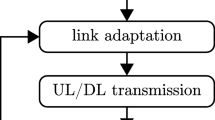Abstract
Simulation is a widely used technique in understanding and analyzing the properties and behavior of wireless networks. Simulation models abound in the wireless domain. Most of these models suffer from an abundance of parameters. Different models might use different parameters. Moreover, even for common parameters, there are no universally accepted standard values. This makes the task of analyzing simulation results a complicated one.
We propose a framework to address this problem. One component of our framework is based on the reduction of the vast parameter space to a smaller, more compact one that encompasses only a few essential parameters. These parameters try to aggregate other parameters and hide the specifics of the underlying system, thereby easing the task of evaluating simulation results.
The other component is based on a novel concept called steady state utilization which tries to capture the inherent capacity of a network. Using steady state utilization as the maximum potential capacity (without loss) of a network, we show how it can be used in the task of comparing results from different simulation models.
This research is partially supported by funds from the Johnson Family Chair.
Access this chapter
Tax calculation will be finalised at checkout
Purchases are for personal use only
Preview
Unable to display preview. Download preview PDF.
Similar content being viewed by others
References
A.R. Aljadhai and T.F. Znati. A framework for call admission control and qos support in wireless environments. Proceedings of IEEE INFOCOM’ 99, pp. 1019–1026, 1999.
S. Bajaj, L. Breslau, D. Estrin, K. Fall, S. Floyd, P. Haldar, M. Handley, A. Helmy, J. Heidemann, P. Huang, S. Kumar, S. McCanne, and R. Rejaie. Improving simulation for network research. USC Computer Science Department Technical Report, March 1999.
H. Balakrishnan, V. N. Padmanabhan, S. Seshan, and R. Katz. A comparison of mechanisms for improving tcp performance over wireless links. IEEE/ACM Transactions on Networking, 5(6):756–769, December 1997.
V. Bharghavan and J. P. Mysore. Profile-based next-cell prediction in indoor wireless lans. IEEE International Conference on Networking, 1997.
J. Jobin, Michalis Faloutsos, Satish K. Tripathi. Performance Evaluation of Mobile Wireless Networks: A New Perspective. Fourth ACM International Workshop on Modeling, Analysis, and Simulation of Wireless and Mobile Systems, 2001.
J. Jobin, Michalis Faloutsos, Satish K. Tripathi. Simplifying the Analysis of Wireless Cellular Network Simulation. International Symposium on Performance Evaluation of Computer and Telecommunication Systems, 2002.
T. C. Fall. A framework for the simulation experimentation process. Proceedings of the 1997 Winter Simulation Conference.
P. Huang, D. Estrin, and J. Heidemann. Enabling large-scale simulations: Selective abstraction approach to the study of multicast protocols. Proceedings of the Sixth International Symposium on Modeling, Analysis, and Simulation of Computer and Telecommunications Systems (MASCOTS’ 98), Montreal, Canada, July 1998.
Y. Iraqi and R. Boutaba. A novel distributed call admission control for wireless mobile multimedia networks. Proceedings of the third ACM international workshop on wireless mobile multimedia, pp. 21–27, 2000.
B. Li, C. Lin, and S. T. Chanson. Analysis of a hybrid cuto. priority scheme for multiple classes of trafic in multimedia wireless networks. Wireless Networks, 4:279–290, 1998.
J. R. Moorman, J. W. Lockwood, and S.-M. Kang. Real-time prioritized call admission control in a base station scheduler. Proceedings of the third ACM international workshop on wireless mobile multimedia, pp. 28–37, 2000.
S. Singh. Quality of service guarantees in mobile computing. Journal of Computer Communications, 19:359–371, 1996.
Author information
Authors and Affiliations
Editor information
Editors and Affiliations
Rights and permissions
Copyright information
© 2002 Springer-Verlag Berlin Heidelberg
About this paper
Cite this paper
Tripathi, S.K., Jobin, J., Faloutsos, M. (2002). Understanding Wireless Mobile Systems: A Simplified Simulation Approach. In: Das, S.K., Bhattacharya, S. (eds) Distributed Computing. IWDC 2002. Lecture Notes in Computer Science, vol 2571. Springer, Berlin, Heidelberg. https://doi.org/10.1007/3-540-36385-8_11
Download citation
DOI: https://doi.org/10.1007/3-540-36385-8_11
Published:
Publisher Name: Springer, Berlin, Heidelberg
Print ISBN: 978-3-540-00355-7
Online ISBN: 978-3-540-36385-9
eBook Packages: Springer Book Archive




